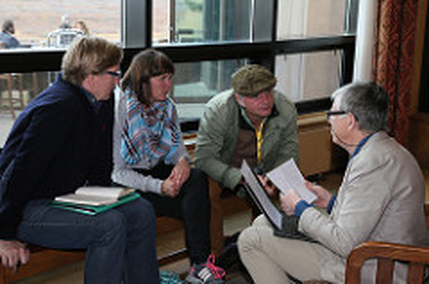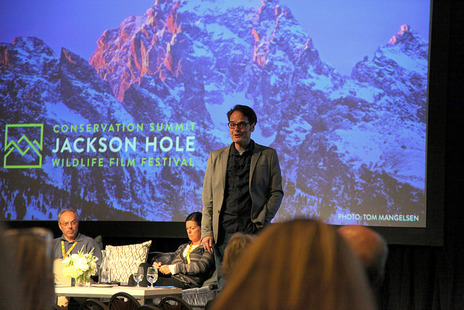|
By: Lizzie Stallings 1. Define your ‘story’: What’s your subject? Why is it interesting?This does not mean that you have to know the end to your story yet; you could just have an interesting lead worth exploring. Let the story tell its own conclusion. After all, the beginning stages are just that: the beginning. 2. What’s your chosen format?How will you tell your story? Think of what you’re trying to communicate: would it work best as a long-form film? Short-form? Should it be episodic? Photographic? A novel? An app? This will help clarify what information you should and should not include, and stylistically, how to include it. 3. What’s your angle? Is your story about Big Foot? The Great Pyramids? A lemur who can spell? Great! Now clarify why your take is original. It’s alright if aspects of your story have been told before—with Big Foot, they have been—but originality is key in developing your narrative. Always keep in mind: am I answering a compelling question? 4. Who is your talent? Regardless of format, your audience will only connect with your story if your character or characters render some sort of emotion, inspiration, or intrigue. Humanize them, make the relatable; your talent is part of your ‘hook’, and will hold the attention of potential sponsors, producers, publishers, viewers and readers alike. 5. Who is your audience?Are you trying to educate or dazzle them, or both? Are you trying to advocate a cause? (Of course you can have other purposes, but consider your purpose with regard to who will be viewing or reading your content.) What age? This consideration could help inform steps 2-4 as well! 6. Who are YOU to your audience?Remember, your position as author, director, or builder (etc) will be relevant to the audience if you want it to be. For instance, an actress advocating for an end to elephant poaching can make her point as an actress. If you are a scientist, data might validate your claims. Certain details about you as creator might come across in your story. If that helps move the story along, allow them to! 7. What would you like to see as the end result?Again, this is intertwined with steps 1-6, but once you’ve defined your quest and purpose, having a clear vision for the future of your story could help you in pursuing “the next step”! 8. What’s your outlet?This is not the same question as “what’s your chosen format”; your outlet is the platform through which your story will be published, promoted or viewed. For instance, by posting episodes or films online, you have an opportunity to include an interactive component. This could be great for projects with “education” in mind. A few good reminders:Should you wish to broadcast or publish your piece, remember you’ll have to pitch it! Answering these questions for yourself will help you in developing a theme or proposal surrounding your story. As Jared Lipworth of National Geographic reminded us, “Treat your story (or pitch) like a funny joke or a gift to your audience. Think, ‘I have to set up a punch line and once you see that punch line, you’ll be hooked.’” Also remember, “Don’t pitch in the bathroom!” *** This advice comes from the information shared at our Jackson Hole Wildlife Film Festival panels, “Crafting the Perfect Pitch” and “The Art and Science of Effective Storytelling.” A Special Thank-You to our speakers on those panels: Lucinda Axelsson, BBC
Sabine Holzer, Head of TV at Terra Mater Factual Studios Jared Lipworth, V.P. of Specials at National Geographic Studios Carole Fleisher, President of Fleisherfilm Emre Izat, Executive Producer of Off the Fence Productions Katie Carpenter, Everwild Media & Yale University Dan Kahan, Professor of Law and Psychology at Yale University Laurie David, Producer of An Inconvenient Truth Carl Safina, Carl Safina Institute Jody Gottlieb, Vulcan Productions ***
0 Comments
By: Lizzie Stallings Southeast Asia: The Threat in the TrekThis past semester, I was fortunate enough to travel around Southeast Asia. In Laos, Vietnam, and Thailand, particularly, ‘elephant trekking’ is advertised to tourists nearly everywhere. The opportunity to ride and/or feed and/or interact with these grandiose creatures is easily realized for a small price of about $25 for a day-long excursion. Admittedly, I, too, visited one of these camps. I had been warned “not to ride the elephants”, just as I had been warned “not to go to Tiger Sanctuaries”, and while I knew that one shouldn’t, I chalked the reasoning up to vague terms like ‘maltreatment’ and ‘captivity’. Call me naïve, and you wouldn’t be wrong. So when I went to ‘trek’, it was with an unsettling hesitance in my stomach, but not an absolute conviction to avoid this activity at all costs. I had friends that wanted to go, and it seemed fitting to do so in Thailand, ‘The Land of White Elephants’. (Laos, Thailand’s neighbor, is ‘The Land of a Million Elephants’. Similar connotation). We went to Nosey Parker’s Elephant Camp in Krabi, a place with a good reputation that allowed us to ride the elephants through the jungle. The sun was blazing over the mountains in the distance while the baby elephants walked alongside their mothers; in all, it was quite picturesque. Then, we got back to the base camp. The discomfort I had felt earlier escalated to mild nausea as the baby elephants “performed”, twirling hula hoops around their trunks, dancing, and walking in sync. It was entertaining but unnatural, cute but unnerving. They were chained and trained. And while I am in no way accusing Nosey Parker’s of the same maltreatment pictured in books like Water for Elephants, I wish I’d known that when people said “don’t ride the elephants”, it was not because every sanctuary or camp mistreated their animals. “Don’t ride the elephants” should be expanded to “Don’t ride the elephants because it feeds into an industry of corruption and illegality. Don’t ride the elephants because not all places are bad, but some are, and it’s hard to tell the difference. Don’t ride the elephants because they should be left in the wild. Captivity, human expansion, and poaching encroach on the survival of the largest land mammals on earth, and riding the elephants only feeds this dangerous fire. Don’t ride the elephants, but know why.” N.B.: Before I make the sweeping declaration, “don’t ride the elephants”, let me acknowledge that there are some places that serve as a rehabilitation center and sanctuary for rescued elephants. They treat their elephants well and provide a home for previously domesticated animals no longer needed for land labor. I have listed a few such places at the end of this post. Visiting such reserves is part of a friendlier vein of ecotourism, but oftentimes, it is difficult to obtain completely reliable information about the nature of the elephant caretakers. Despite the amiable claims of many camps, there can be dark histories behind their ownership and maintenance of domestic elephants. Calf Capture: Before You Ride The ElephantsAs I have already mentioned, there is a shadow cast over, under and beyond the seeming merriment of saddling an elephant whilst travelling through Asia. The illegal capture of baby elephants occurs in Africa as well, but transport across the Burma-Thailand border proves highest in frequency. The calves are taken from the wild, violating government imposed wildlife protection laws to feed the growing demand for elephant camps amongst tourists. Capturing the calves is a treacherous process, and more often than not, the mothers and other surrounding adults are killed protecting their young. Not for the faint of heart, here is a video of an instance of smuggling. Much like the unfortunate reality of the ivory trade, the economic benefit of illegally capturing and domesticating elephants motivates these poachers and smugglers to break the law. They mercilessly beat and kill these animals, incentivized by the growing demand of the industry. Breaking the Calf Once captured, these calves are then “domesticated”. In order to train the elephants for performances and “safe” trekking—aka safe for the human riders—the animals must be ‘broken’ from a young age. Captors use fear and aversion techniques called bajaan (‘breaking of the calf’) to prepare the elephants for domestication, but they must begin training at a young age, as older elephants are far more reactionary and dangerous when captured. The process of bajaan adheres to its translation; the elephants are beaten, caged, and cruelly ‘disciplined’ to ready them for their futures as tourist attractions. Again, this video is difficult to watch; this is just one instance of the common training process that occurs in Thailand. In many countries, bajaan is known not only as a training technique. It is acknowledged as a destruction of the spirit. If You Still Want to RideIt’s only natural to want to engage with these majestic creatures. They are beautiful, smart, and impressive, so the appeal is not difficult to comprehend. There are, too, some reputable sites across Southeast Asia, India, and Africa, in which elephants are taken in, post-torture, and rehabilitated. Elephant Nature Park, Thai Elephant Conservation Center and Boon Lott’s Elephant Sanctuary are all respectable locations in Thailand that put the elephants’ priorities first. Tourists can interact with elephants, but in a safe, moderated environment with the knowledge that the animals are treated kindly and appropriately behind the scenes.
|
Archives
March 2024
Categories
All
|
Contact UsJackson Wild
240 S. Glenwood, Suite 102 PO Box 3940 Jackson, WY 83001 307-200-3286 info@jacksonwild.org |





 RSS Feed
RSS Feed